Podcast 593: Steamy Bedrooms, Windows and WRBs, and Weird Weatherstripping
The crew hears from listeners about sound attenuation, plumbing, and LED lighting. Discussion questions include high-humidity spaces, best building practices, and garage-door weatherstripping.
Follow the Fine Homebuilding Podcast on your favorite app. Subscribe now and don’t miss an episode:
 |
Help us make better episodes and enter for a chance to win an FHB Podcast T-shirt:
www.finehomebuilding.com/podcastsurvey
Jonathan suggests paper products for sound attenuation. Jim cleans his own on-demand water heater. John shares his experience with LED strips. Alex asks about a humid bedroom. Steve wonders about a pair of local building practices. Shawn is introduced to bronze weatherstripping.
Editor Updates:
- Ian’s house: Finishing projects?
- Jeff’s tree branch
- Brian’s house: Deck posts
- Patrick’s dreaded home center visit
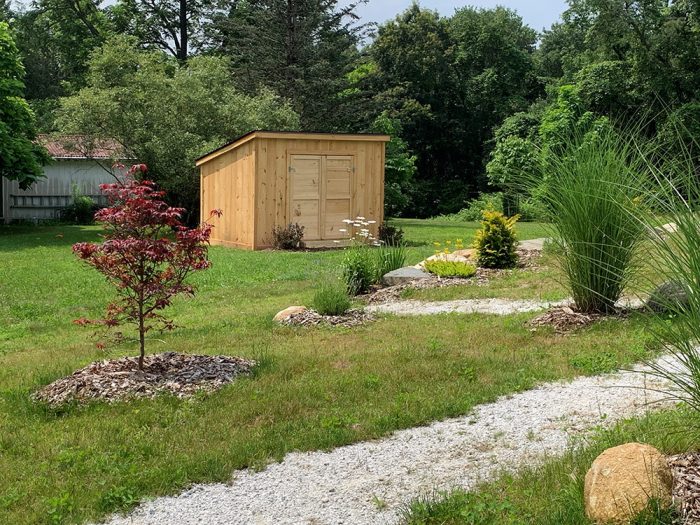 |
 |
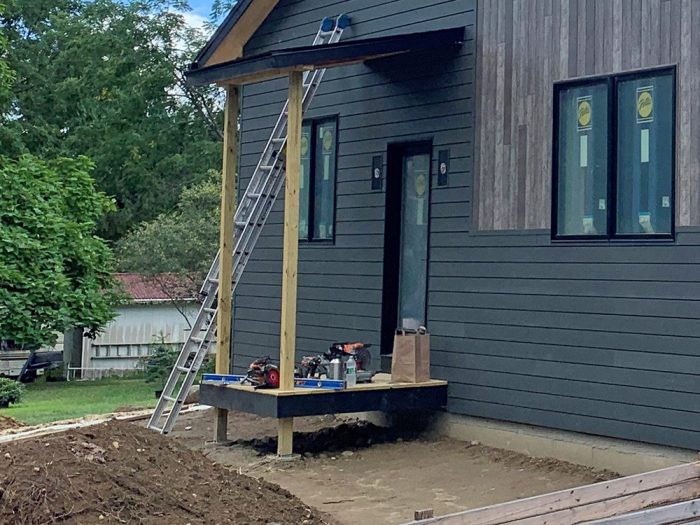 |
Listener Feedback 1:
Jonathan writes: Hello Patrick and the crew!
Thanks for the great work you do and thanks Ian for representing the upper Midwest! On episode 581, you tried to help Sam with a sound-dampening problem in a rented house. While various solutions were suggested, the solution of heavy fabric or dense foamed materials can also prove to be a highly effective, ultra temporary solution for this.
While working for Kimberly-Clark, a virtual charity auction was held for personal care products, so I bid on some toilet paper. What I didn’t know was that:
- The toilet paper was not for a pack of 12 but for a case of 4 packs.
- Bidding low and expecting to get outbid on most of your bids was delusional.
Naive me ends up winning 19 cases (or 76 packs, or 912 rolls of toilet paper)!!! I ended up pulling up to this warehouse and somehow, by the grace of God, packing all of these case away in my tiny Saturn SL sedan. What that turned into was the single quietest ride of my life. I didn’t hear other cars, road noise, or even my own engine. I felt at ease and completely relaxed. What better way to ease my stress than complete silence and knowing that if I crash, the toilet paper will cushion the impact?
I learned that a personal, portable anechoic chamber is only 912 rolls of toilet paper away. Maybe Sam should look to the paper products aisle of Target for some acoustic treatment?
Regards from a hobbyist home remodeler,
Jonathan
Related Links:
- Building Soundproof Walls
- Better Sound Absorption With Slat Wood Wall Panels
- Scientific.Net: Recycled Paper Fibres as Sound Absorbing Material
Listener Feedback 2:
Jim writes: Dear FHB Plumbers (not the Watergate kind),
In Podcast 583 you discussed cleaning a tankless on-demand water heater. When we built our house in 2008, we had a Rinnai propane unit installed. A few years later I learned it needed to be cleaned annually. I called a plumber and he said he didn’t want to waste my money and told me how to clean it myself. He also told me there are several YouTube videos that explain how to do it. With a small investment of a small transfer pump (around $65 at Harbor Freight), some short hoses (washing machine hoses work great), a bucket, and a gallon of white vinegar, you are ready. All it takes is turning off the power, gas, and water to and from the heater. Then attach the hoses at the connections at the bottom of the unit from a bucket filled with the vinegar and circulate it through the heater for an hour and then flush it with water for few minutes. It is amazing how much junk it cleans out, and we have public water service.
We did have to have the burner unit cleaned a couple of years ago by a plumber when the burner unit in the heater stopped working.It was something I would never attempt myself, but I was happy to hold the flashlight.
I do have a plumbing question. We have a problem with our water staining the fiberglass shower tray and fiberglass bathtubs a copper green. It does scrub off, but it is a hassle. My research has shown that either the water pH or electrolysis in the water is causing the shower and faucet fixtures to slowly corrode, discoloring the fiberglass. Our water softener company tests the water annually when they service the unit and the pH is neutral. I’ve read that the water pipes need to be grounded to neutralize the electrolysis. The problem is how do I ground a system that is 99% PEX pipe except for the water connections around the water heater and the faucets?
Thank you as always for an interesting, informative, and entertaining podcast. Even though as lowly homeowner I don’t understand half of what you are talking about, I’m learning.
Jim
Related Links:
- Tankless Water-Heater Maintenance
- Draining and Flushing a Water Heater
- How a Tankless Water Heater Works
Listener Feedback 3:
A listener writes: I was listening to episode 583 when you all were talking about LED strip lighting. I, too, was confused with all of the different options/connectors. A few things that have worked well for me.
I’ve done my kitchen and coffee bar with LEDs hot-glued into strips of hardwood with a 3/8-in. routed groove (shown in the attached picture). This really helped keep the strips secured without drooping or losing the sticky backing over time. The Barrel connectors listed below from Amazon make it super easy to disconnect if you ever have to do any re-soldering or replace a strip. Also, soldering is the only way to go. Just be sure to melt/scrape off the thin layer of silicone that often covers the leads on the strips.
If you are looking for a practical project with LED strips, try doing under-bed lighting with 2700K strips. Mounted about 1 ft. under the bed and wired to the occupancy sensors below, the lights make nighttime arrivals or departures from the bed less hazardous. I’ve attached a picture from my project: three zones with three different sensors (left, right, and the foot of the bed). It’s a game changer!
 |
 |
Related Links:
Question 1: Why is the bedroom so humid and how do I fix it?
Alex writes: Hi Patrick et al.,
I just posted this question to the GBA forum, and it occurred to me I should ask the podcast too. Have any thoughts? I love the podcast.
My son’s room is incredibly humid—sometimes 76 percent. We are in western Mass. The room is south-facing, and the wood clapboards outside get baked by the sun. We have minisplits, and had cellulose blown into the wall cavities a couple years ago. He keeps his A/C quite low, like 68 or 70 degrees. I am vaguely familiar with terms like “vapor drive,” and have limited understanding of building science in general. But after some research, I suspect the sun is driving vapor into the walls, and it is condensing on the back side of his cool plaster walls, then making the room humid.
Does that sound plausible? Is it a result of having cellulose blown in? And if this has been happening for a year or two, is there likely a mold problem in his walls? How should I address the humidity and the possibility of a mold problem?
Thanks for any advice.
Related Links:
- GBA.com – Community and Q&A: Humid Room question
- How it Works: Vapor Drive
- Tight houses and moisture problems
- GBA.com: Two Rules for Humidity
Question 2: Are these building practices really “best practice”?
Steve writes: Hey Gang,
Thanks for your feedback in episode 521 regarding local code enforcement and blower-door testing. Ian said “maybe you should become the blower door guy.” This was already something I wanted to do, so, in the time since I last emailed you, I opened an LLC and bought a blower door. Then with financial assistance from the local gas company’s workforce development fund, I’ve gotten a number of certifications from the Building Performance Institute (BPI) So, thanks Ian for getting me to spend thousands of dollars. I guess an all-access membership doesn’t sting anymore, but a discount to GBA would be cool.
In all seriousness, I do have a huge debt of gratitude to everyone that has hosted this podcast, as well as others in the FHB sphere of influence, including Matt Risinger’s Build Show Podcast, The Building Science Podcast, The Unbuild It Podcast, E3 Podcast with Emily Mottram, and The Contracting Handbook Podcast. The rabbit hole of building science has reawakened my love of learning, and I have finally gotten started on the path to a career I want. Thank you all.
I have some questions.
- I’ve noticed some framing crews in my area will nail wall plates to the subfloor first, then assemble studs to the top plate only. Then they have to manipulate these dangling wall sections into place before toenailing the studs down. I’ve heard this is because the framing inspector wants to be able to see two nails per stud on the bottom. This seems like a funny desire that’s leading to poorer quality and slower processes. Any thoughts?
- In the same vein, windows are almost universally installed before the WRB. This seems counter to all off the “best practice” information I’ve seen, as well as manufacturer install details. So what’s the trick to no problems when this is the order of operations?
- When it comes to the issue of energy codes and who is the contractor to perform these new tasks, why isn’t the obvious choice energy raters? Here we have these individuals trained in “the house as a system” philosophy who currently don’t get their hands dirty. They have the knowledge of how to tie processes and products together into cohesive control layers. They understand that doing a crappy job on said tasks undermines the entire thing. It seems like if you tell a builder “Hey, you gotta pay extra to have this new subcontractor tell you that you’re doing stuff wrong,” and then say call me when you fix it and I’ll come back, that builders won’t like that. Why is there this disconnect between raters and doing the tasks that can most affect the ratings? I hope this makes sense, because this is exactly where I want to corner my market.
Anyway, keep up the great work, and thanks again,
Steve
Related Links:
- The Evolution of Top-Plate Building Codes
- Part 1: Prepare a Rough Opening for a Nail-Fin Window over a Fluid-Applied WRB
- Using a Blower-Door Test and Interpreting the Results
Question 3: What kind of weatherstripping is this?
Sean in Atlanta writes: Hi FHB,
I’ve been very busy with school and work and unfortunately fell behind on the podcast. I’ve also been in landscaping mode and have taken down several trees and removed 40+ lawn bags of yard waste. Good news, though. I recently caught up and have several comments from past episodes. I also have a question at the end.
- Responding to question about questions a first-time home buyer should ask:
- Buying a house is likely the most expensive asset or purchase one will make in their life. I think purchasing a home without the “traditional” team of closing attorney and real estate agent is ill-advised. These are professionals who do this every day, and they know where the pain points are. Get an inspection and pay for all the extra things (sewer scope, thermal imaging, radon, etc.). This might seem unnecessary and costly, but this is your last shot to uncover an issue that could cost tens of thousands later and then renegotiate the purchase price. I also highly recommend a boundary survey and staking of the property. This uncovered a discrepancy between the survey and easements on our property that required back and forth with our closing attorney before closing.
- Dehumidification in Zone 3A:
- Whole-home dehumidification here is almost a requirement. I sent an email responding to Ian last year when he needed a dehumidifier for his downstairs. I won’t repeat those thoughts here.
- The only thing I will add to that email is how to sell this to a spouse. My wife thought the purchase was not necessary. However, she now is a firm believer and tells her friends. Apparently, the reduction in humidity in the house has significantly reduced the amount of time it takes for her to get ready in the morning. Humidity and hair do not play well together and causes styled hair to become “frizzy” as soon as you step outside. She also comments that her skin is in better shape, but I’m not sure what that means exactly.
- Another thing to remember is that you might be able to raise the cooling target as the humidity drops. Most people end up lowering the cooling-target temp because of how uncomfortable high humidity can be. We ended up raising our target temp 2 degrees once our humidity issue was under control.
Now here’s my question: I am about to replace the weatherstripping on the door to my garage, but I’ve been perplexed by the door jamb since we moved in. The door jamb has these very thin pieces of metal stapled along the sides and top. They are on top of the hinges, so they were installed last or close to it. They do not seem to serve any purpose, and I plan on removing them and filling the staple holes. They are likely original to the home (1986). Any idea of what these are for?
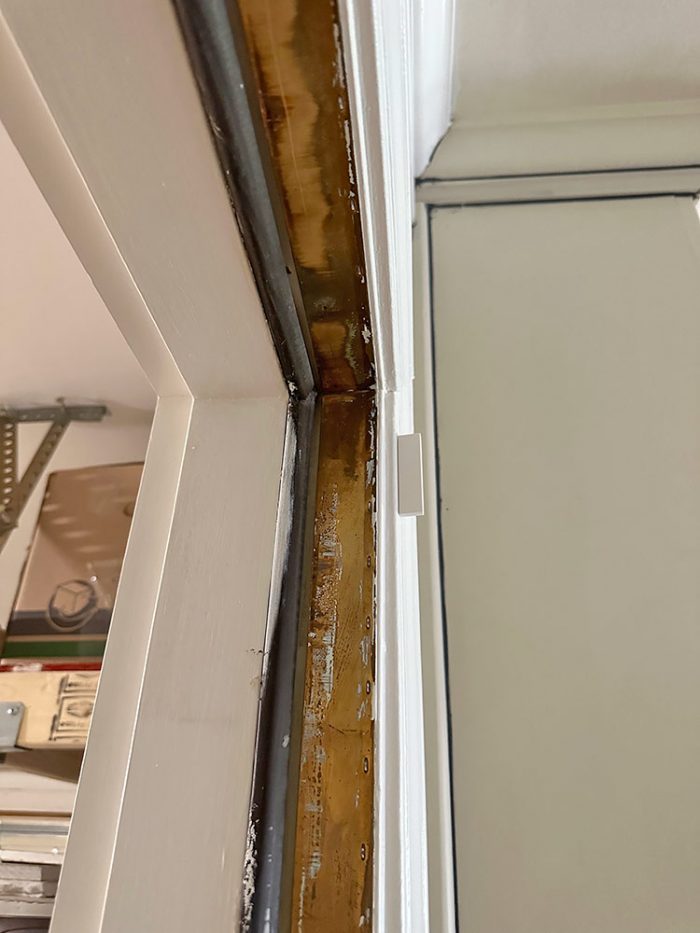 |
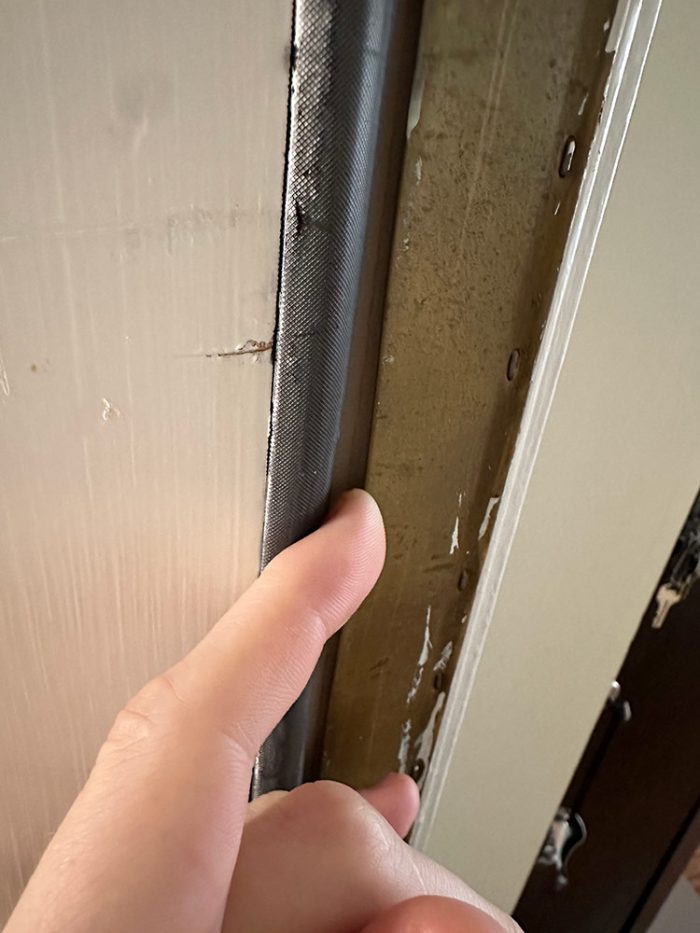 |
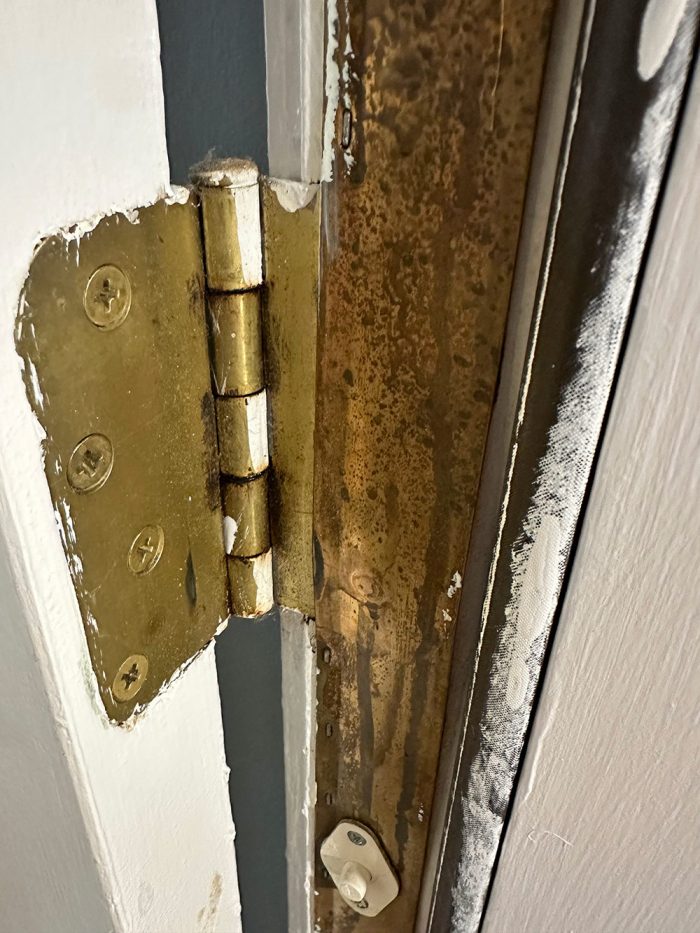 |
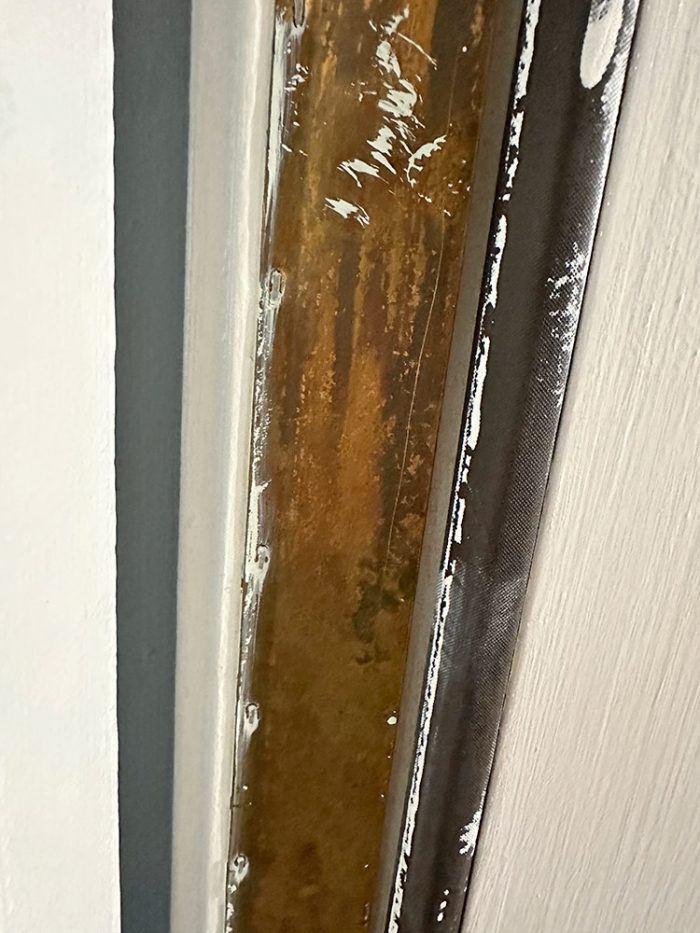 |
Thanks,
Sean (MBA and engineering/physics student!)
Related Links:
- Weatherstripping Door Frames
- Interlocking-weatherstripping techniques
- Build Like a Pro: Weatherstripping a Door
END NOTE:
Podcast 593: Members-only Aftershow — Low-as-you-can-go Net-zero
What is the least expensive near net-zero house you can build?

When it comes to performance and lead times, trust is everything. Marvin gets that. Now their Marvin Elevate® and EssentialTM collections have significantly lower lead times. You know these windows and doors for their beautiful designs, durable Ultrex fiberglass, on-trend styles and colorways—well, now you can have them delivered for your project in less time to help keep your timeline intact. Speaking of trust, Marvin’s shipping complete and delivered as promised more than 90% of the time across all products and options. So, when you want the right performance, right on time, know Marvin delivers.
Check out one of our latest Project Guides: Energy Retrofit!
Check out our FHB Houses:
Visit the Taunton Store • Magazine Index • Online Archive • Our First Issues • All Access
Help us make better episodes and enter for a chance to win an FHB Podcast T-shirt: www.finehomebuilding.com/podcastsurvey

If you have any questions you would like us to dig into for a future show, shoot an email our way: fhbpodcast@taunton.com.
If we use your question we’ll send you a FHB Podcast sticker!
FHB Podcast T-shirts!
Represent your favorite podcast! Available in several styles and colors. Made from 100% cotton. Find the Podcast t-shirt and more cool products in the Fine Homebuilding Store.
| Fine Homebuilding podcast listeners can now get 20% off anything in the Taunton store, including Pretty Good House.
Use the discount code FHBPODCAST to take advantage of this special offer. |
 |
“Finally, knowledgeable people talking about building reasonably-sized, high-performance houses for normal people with real budgets!” — DanD, VA, 8/19/22, Amazon.com review |
We hope you will take advantage of a great offer for our podcast listeners: A special 20% off the discounted rate to subscribe to the Fine Homebuilding print magazine. That link goes to finehomebuilding.com/podoffer.
The show is driven by our listeners, so please subscribe and rate us on iTunes or Google Play, and if you have any questions you would like us to dig into for a future show, shoot an email our way: fhbpodcast@taunton.com. Also, be sure to follow Fine Homebuilding on Instagram, and “like” us on Facebook. Note that you can watch the show above, or on YouTube at the Fine Homebuilding YouTube Channel.
The Fine Homebuilding Podcast embodies Fine Homebuilding magazine’s commitment to the preservation of craftsmanship and the advancement of home performance in residential construction. The show is an informal but vigorous conversation about the techniques and principles that allow listeners to master their design and building challenges.
Other related links
-
- All FHB podcast show notes: FineHomebuilding.com/podcast.
- #KeepCraftAlive T-shirts and hats support scholarships for building trades students. So order some gear at KeepCraftAlive.org.
- The direct link to the online store is here.
































